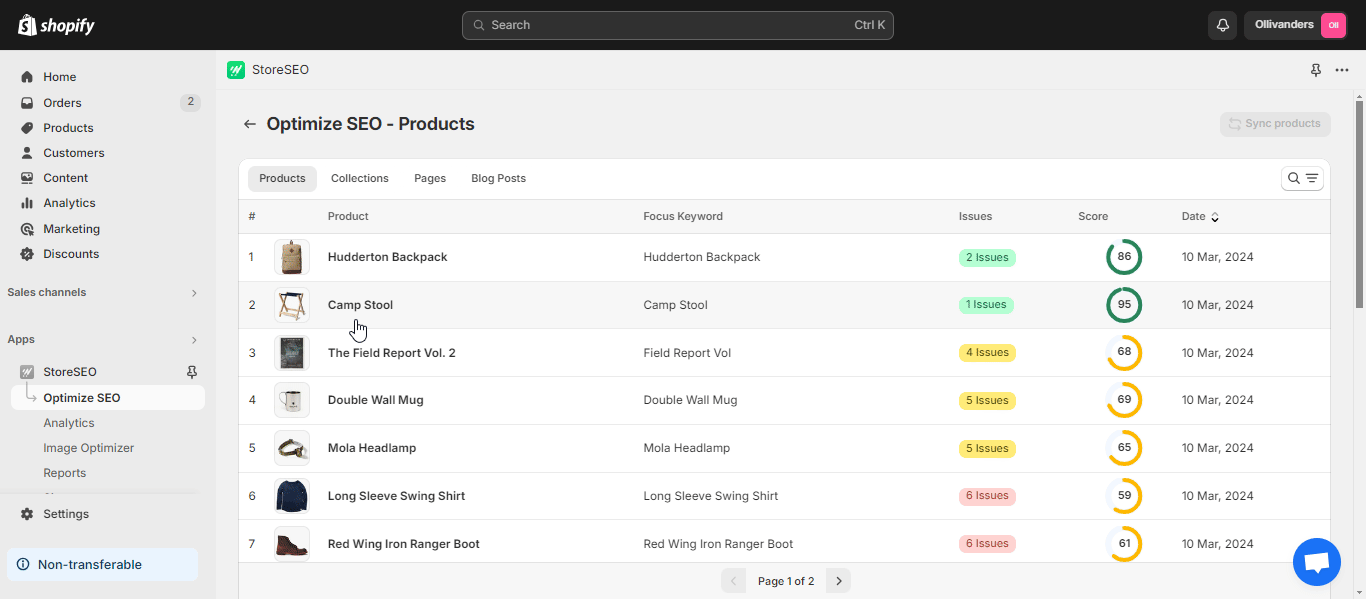Die Bedeutung von SEO-freundlichen URLs für Shopify-Shops kann nicht übersehen werden, da die Konkurrenz nur einen Klick entfernt ist. Diese kleinen Komponenten Ihrer Website haben eine enorme Macht und dienen als wichtige Brücke zwischen Ihren Inhalten und potenziellen Kunden. Aber wie erstellt und ändert man SEO-freundliche URLs für Shopify und was genau macht eine URL SEO-freundlich? Es geht darum, ein nahtloses Erlebnis zu schaffen, das Benutzer direkt zu Ihrem Shopify-Shop führt. In diesem Blogbeitrag untersuchen wir, wie Sie die URLs Ihres Shopify-Shops für eine bessere Leistung optimieren können.

Die Struktur von Shopify-URLs
Wenn Sie Ihren Onlineshop mit Shopify einrichten, kann Ihnen das Verständnis der Struktur Ihrer URLs dabei helfen, Ihre Site besser zu verwalten. Standardmäßig haben Shopify-URLs ein vorhersehbares Muster. Produktseiten sehen beispielsweise normalerweise so aus:

„yourstore.com/products/Ihr-Produktname”
Ebenso erscheinen Produktsammlungen als „yourstore.com/collections/your-collection-name“. Diese Struktur ist ziemlich unkompliziert und hilft, die Dinge von Anfang an organisiert zu halten.
Bedeutung der Konsistenz in der URL-Struktur für die Benutzernavigation und SEO
Die Aufrechterhaltung einer konsistenten URL-Struktur ist nicht nur für SEO, sondern auch für die Verbesserung der Benutzernavigation von entscheidender Bedeutung. Einheitliche URLs schaffen eine vorhersehbare Umgebung für Ihre Besucher und erleichtern ihnen das Navigieren auf Ihrer Website und das Erwarten, wenn sie auf einen Link klicken.
Aus SEO-Sicht ermöglicht eine logische und konsistente URL-Struktur Suchmaschinen, Ihre Site effektiver zu crawlen und die Beziehung zwischen verschiedenen Seiten zu verstehen. Dies kann dazu beitragen, die Indizierung und das Ranking Ihrer Site in Suchergebnissen zu verbessern. Wenn Sie Ihre URLs also organisiert und logisch halten, ist das sowohl für Ihre Benutzer als auch für Ihre SEO-Bemühungen eine Win-Win-Situation!
Erstellen von SEO-freundlichen URLs in Shopify
SEO-freundliche URLs in Shopify sind ein entscheidender Schritt, um die Sichtbarkeit Ihres Shops und sein Suchmaschinenranking zu verbessern. Wir erklären Ihnen anhand einer Schritt-für-Schritt-Anleitung, Best Practices für die URL-Benennung und Tipps zur Vermeidung häufiger Fehler, wie Sie dies erreichen können.
Ändern und Erstellen SEO-freundlicher URLs in Shopify
Wenn Sie neue Seiten in Ihrem Shopify-Shop einrichten, müssen Sie darauf achten, dass Ihre URLs für Suchmaschinen optimiert sind. So können Sie das tun:
Best Practices für URL-Benennungskonventionen
Um das Beste aus Ihren URLs herauszuholen, befolgen Sie diese Best Practices:
- Verwenden Sie Schlüsselwörter: Fügen Sie Ihren URLs relevante Schlüsselwörter hinzu, um die SEO Ihrer Seite zu verbessern. Wenn Sie beispielsweise Vintage-Lampen verkaufen, könnte Ihre URL etwa lauten: „www.yourshop.com/vintage-lamps.”
- Verwenden Sie Bindestriche, um Wörter zu trennen: Verwenden Sie anstelle von Unterstrichen oder Leerzeichen Bindestriche, um Wörter in Ihrer URL zu trennen. So können Suchmaschinen sie leichter lesen und verstehen.
- Halten Sie es klein: Verwenden Sie in Ihren URLs immer Kleinbuchstaben, um Verwirrung zu vermeiden, da bei URLs die Groß- und Kleinschreibung beachtet wird.
So vermeiden Sie häufige Fehler beim Erstellen von URLs
Beim Erstellen und Ändern von SEO-freundlichen URLs für Shopify können leicht Fehler passieren, die Ihrer SEO schaden können. Hier sind einige Tipps, um sie zu vermeiden:
- Vermeiden Sie die Verwendung langer URLs: Halten Sie Ihre URLs kurz und prägnant. Lange URLs sind für Suchmaschinen schwer zu verarbeiten und werden möglicherweise nicht vollständig in den Suchergebnissen angezeigt.
- Vermeiden Sie Sonderzeichen: Sonderzeichen und Symbole können Ihre URL beschädigen und sie sowohl für Benutzer als auch für Suchmaschinen weniger zugänglich machen.
- Füllen Sie keine Keywords voll: Schlüsselwörter sind zwar wichtig, aber ihre übermäßige Verwendung kann dazu führen, dass Ihre URL wie Spam aussieht. Verwenden Sie sie mit Bedacht.
Erweiterte Tipps für SEO-freundliche URLs
Das Erstellen und Ändern SEO-freundlicher URLs für Shopify ist entscheidend, um die Sichtbarkeit und Benutzerfreundlichkeit Ihrer Website zu verbessern. Hier finden Sie einige erweiterte Tipps und Strategien zur Optimierung Ihrer URLs, insbesondere wenn Sie Plattformen wie Shopify verwenden.
Apps und Tools von Drittanbietern zum Erstellen und Ändern SEO-freundlicher URLs für Shopify
Die standardmäßige URL-Struktur von Shopify ist im Allgemeinen SEO-freundlich, aber es kann Szenarien geben, in denen Sie SEO-freundliche URLs für Shopify erstellen und ändern müssen, um sie Ihren spezifischen SEO-Zielen anzupassen. Wenn Sie beispielsweise bestimmte Schlüsselwörter ansprechen oder URLs besser an die Suchabsicht der Benutzer anpassen möchten, sollten Sie Ihre URLs über die grundlegenden Pfade „/products/“ oder „/collections/“ hinaus anpassen.
Shopify bietet eine Vielzahl von Apps, mit denen Sie Ihre URLs für eine bessere SEO-Leistung optimieren können. Apps wie StoreSEO kann das gesamte Verfahren vereinfachen und den gesamten Arbeitsablauf vereinfachen, zusammen mit Metafeldbearbeitungen auch. Um URLs in Shopify anzupassen, können Sie die StoreSEO-App verwenden. Stellen Sie sicher, dass Sie installiert und aktiviert die App, bevor Sie darauf zugreifen. Hier ist die Schritt-für-Schritt-Anleitung dazu:
Schritt 1: Zugriff auf die StoreSEO-App
Lassen Sie uns durchgehen, wie Sie auf diese Vorschauen zugreifen und sie bearbeiten können, um Ihren Shop attraktiver zu gestalten. Gehen Sie zu StoreSEO und klicken Sie auf „SEO optimieren“.

Schritt 2: Produkt auswählen
Wählen Sie nun das Produkt aus, für das Sie den Suchmaschineneintrag bearbeiten möchten, und klicken Sie auf das Produkt selbst. Sie gelangen dann zum Abschnitt „Optimierung“.

Schritt 3: Details bearbeiten
Jetzt werden Ihnen die Felder zum Bearbeiten Ihrer Produkt-URL sowie anderer Metafelder angezeigt. Gehen Sie sie nacheinander durch und bearbeiten Sie sie entsprechend.

Schritt 4: Überprüfen Sie die endgültige Vorschau
Wenn Sie mit der URL-Änderung fertig sind, scrollen Sie nach unten und überprüfen Sie die Vorschau aller für die Vorschau bereitgestellten Informationen.

So einfach können Sie Ihren Suchmaschineneintrag auf StoreSEO für Ihren Shopify-Shop bearbeiten und in Echtzeit anzeigen.
Strategien zur Beibehaltung SEO-freundlicher URLs während der Plattformmigration
Die Migration auf eine neue Plattform kann eine Herausforderung sein, insbesondere wenn es darum geht, Ihre SEO-Bemühungen aufrechtzuerhalten. Um SEO-freundliche URLs während einer Plattformmigration beizubehalten, ist es wichtig, Folgendes zu implementieren: 301 Weiterleitungen von alten URLs zu neuen. Dies trägt dazu bei, das Suchmaschinen-Ranking zu erhalten, indem es Suchmaschinen über den neuen Standort Ihres Inhalts informiert.
Eine weitere Strategie besteht darin, eine möglichst konsistente URL-Struktur beizubehalten. Wenn Ihre vorherige Plattform ein bestimmtes URL-Muster verwendet hat, das zu Ihrem SEO-Erfolg beigetragen hat, versuchen Sie, diese Struktur auf Ihrer neuen Plattform zu replizieren. Diese Konsistenz trägt dazu bei, die SEO-Auswirkungen der Migration zu verringern und bietet ein nahtloses Benutzererlebnis.
Überprüfen Sie die Store-Performance mit Tools und Methoden
Gut, wenn Sie Ihre URL erfolgreich optimiert haben, ist es an der Zeit, die Leistung zu überprüfen. Wenn Sie die Leistung Ihrer URLs im SEO-Spiel im Auge behalten möchten, gibt es eine Reihe von Tools und Methoden, die Ihnen einen Vorteil verschaffen können. Zunächst einmal ist die Google Search Console Ihre Anlaufstelle. Sie ist wie ein Gesundheitsmonitor für Ihre Website. Sie zeigt Ihnen, wie Ihre URLs in Suchergebnissen abschneiden, und verfolgt Kennzahlen wie Klicks, Impressionen und durchschnittliche Position. Ein weiteres leistungsstarkes Tool ist Google Analytics, das tiefer in die Interaktion der Benutzer mit Ihrer Website eintaucht, nachdem sie auf eine URL geklickt haben.
Für diejenigen, die noch detaillierter vorgehen möchten, sind Tools wie SEMrush und Ahrefs wie ein leistungsstarkes Mikroskop für SEO. Sie verfolgen nicht nur die URL-Leistung, sondern helfen Ihnen auch, Ihre Konkurrenten auszuspionieren und zu sehen, wo Sie sich verbessern können. Diese Tools bieten detaillierte Berichte zu Keyword-Rankings, Backlink-Profilen und vielem mehr und geben Ihnen so einen umfassenden Überblick über Ihre SEO-Landschaft.
So interpretieren Sie Daten aus der Google Search Console und anderen Analysetools
Die Interpretation von Daten aus der Google Search Console und anderen Analysetools kann entmutigend erscheinen, aber es kommt darauf an, zu wissen, wonach man suchen muss. Konzentrieren Sie sich in der Google Search Console auf die Registerkarte „Leistung“. Hier sehen Sie, wie oft Ihre Website in Google-Suchen erscheint (Impressionen), wie viele Klicks sie erhält und Ihre durchschnittliche Suchposition. Diese Kennzahlen sagen Ihnen viel über Ihre Sichtbarkeit und Attraktivität in Suchergebnissen.
Mit Google Analyticskönnen Sie das Nutzerverhalten nach dem Klick analysieren. Sehen Sie sich Kennzahlen wie Absprungrate, Seiten pro Sitzung und durchschnittliche Sitzungsdauer an, um das Engagement der Nutzer zu messen. Diese Daten helfen Ihnen nicht nur zu verstehen, wie Nutzer Ihre Site finden, sondern auch, was sie tun, wenn sie dort sind.
Für eine breitere Perspektive bieten SEMrush und Ahrefs Einblicke in die Leistung Ihrer URLs im Vergleich zu denen Ihrer Mitbewerber. Sie können Ihnen zeigen, welche Keywords den Verkehr zu Ihren Mitbewerbern lenken und welche Backlinks deren SEO-Bemühungen unterstützen. Diese Art der Wettbewerbsanalyse ist für die Verfeinerung Ihrer SEO-Strategie von unschätzbarem Wert.
Einschränkungen der URL-Struktur von Shopify für SEO
Die URL-Struktur von Shopify ist sauber und ordentlich, aber sie hat einige Einschränkungen, insbesondere hinsichtlich Suchmaschinenoptimierung (SEO). Eines der Hauptprobleme sind die festen URL-Pfade, wie /products/ und /collections/, die obligatorisch sind. Dies kann etwas einschränkend sein, da Sie diese Segmente nicht anpassen können, um möglicherweise SEO-freundlichere Schlüsselwörter einzuschließen oder die URL genau an Ihren Seiteninhalt anzupassen. Außerdem erlaubt Shopify nicht das Entfernen dieser Pfadelemente, was möglicherweise nicht immer den besten SEO-Praktiken entspricht, bei denen einfachere und direktere URLs oft bevorzugt werden.
Passen Sie Ihre URL-Strategie anhand der Leistungsdaten an
Um bei Ihrer SEO-Strategie die Nase vorn zu behalten, ist es wichtig zu wissen, wann und wie Sie Ihre URL-Strategie optimieren müssen. Wenn Sie einen Rückgang der Klicks oder eine niedrigere Position in den Suchergebnissen feststellen, ist es möglicherweise an der Zeit, einige Änderungen vorzunehmen. Beginnen Sie damit, Ihre Keywords neu zu bewerten. Sind sie noch relevant und wettbewerbsfähig? Tools wie die Google Search Console und SEMrush können Ihnen dabei helfen, herauszufinden, welche Keywords unterdurchschnittlich abschneiden.
Eine weitere wichtige Anpassung ist die Verbesserung Ihrer URLs selbst. Stellen Sie sicher, dass sie prägnant sind, relevante Schlüsselwörter enthalten und den Seiteninhalt genau beschreiben. Manchmal können sogar kleine Änderungen, wie das Anpassen eines URL-Slugs, um Suchanfragen besser zu entsprechen, einen großen Unterschied darin machen, wie leicht Benutzer Ihre Inhalte finden können.
Vergessen Sie nicht die technische Seite. Stellen Sie sicher, dass Ihre URLs richtig umgeleitet werden, wenn Sie Änderungen vornehmen, insbesondere während einer Site-Migration oder -Überarbeitung. Eine ordnungsgemäße Umleitung bewahrt Ihre SEO-Qualität und sorgt dafür, dass Benutzer auf den richtigen Seiten landen. Ich hoffe, Sie haben das Konzept verstanden, wie Sie SEO-freundliche URLs für Shopify erstellen und ändern.
Fanden Sie unseren Blog nützlich? Wenn ja, bitte Abonnieren Sie unseren Blog für weitere Tipps, Tutorials und Updates zu branchenbezogenen Themen.









